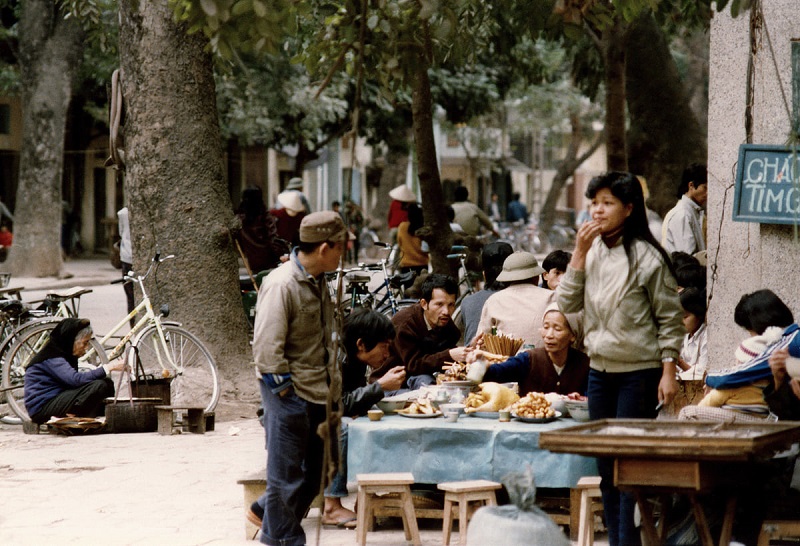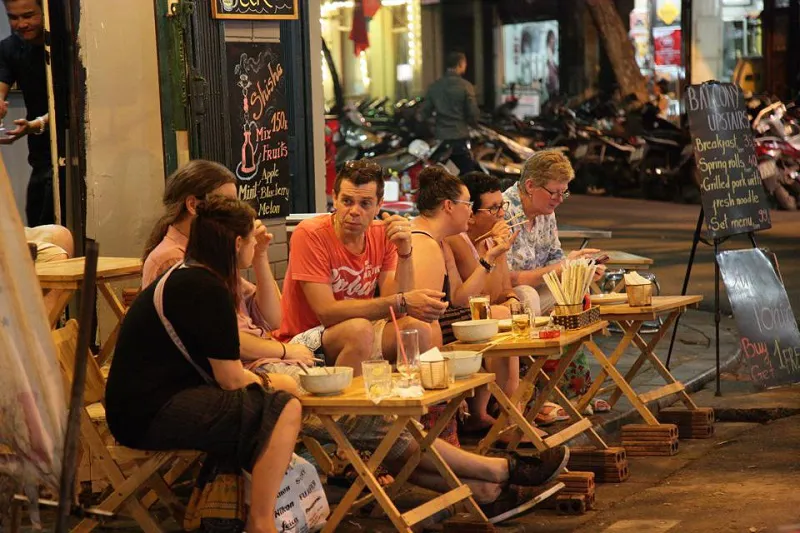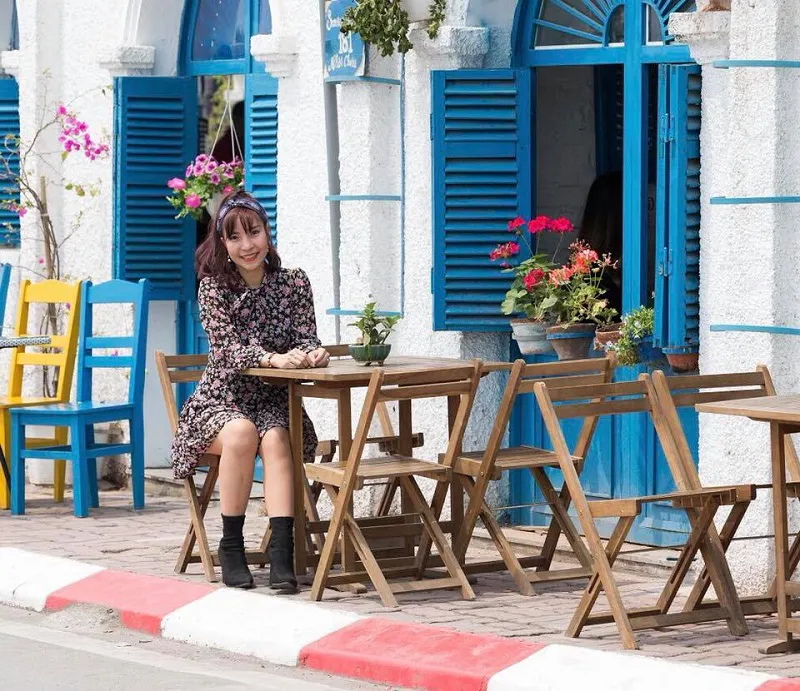The unique sidewalk culture of Hanoi: Daily life on the pavement
Unlike other places in the world, the sidewalk in Hanoi is not just for walking but a multifaceted social space and location of livelihood, partly reflecting the capital city's culture.
According to common sense, a sidewalk is usually a place of passage for pedestrians, as well as for vegetation and urban technical infrastructures, such as electric poles or lights. But for many Hanoians, especially those living in the Old Quarter Area, the sidewalk is a memorable and dispensable part of life.
Interesting space for socializing
| Hanoi sidewalks in the 1990s: A place for gathering. File Photo |
According to writer Do Phan, in 1969, after the cessation of the American bombing and the return of evacuated students to Hanoi, the sidewalks were the playground for children.
During breaks, the sidewalk in front of school gates was crowded with students and stalls selling dry apricot, roasted peanuts, apple mix, crispy dumplings, and candy balls. Boys played soccer or kicked shuttlecocks, while girls skipped ropes or played mandarin square capturing. Outside school hours, kids also practiced riding bicycles or climbing trees to pick tamarinds and dragon plums.
Nguyen Van Huy - Deputy Director at the Vietnam Center for Research and Promotion of Cultural Heritage - explained with The Hanoi Times that ‘Most Hanoians come from the countryside, so the habit of gathering for some tea and chatting on the sidewalk is still a common part of their way of life.’
On the same note, Dr. Nguyen Thi Phuong Cham at the Institute of Cultural Studies under the Vietnam Academy of Social Sciences commented: ‘Sidewalks in Hanoi downtown are truly a living space.’ Remarkably, the sidewalks on streets like Le Van Huu, Thi Sach, Ngo Thi Nham, Tran Xuan Soan, Lo Duc, and Hoa Ma are the cooking and resting places of laborers and vendors. They often spread out a nylon sheet or sack to take a 15-minute midday nap before resuming their work.
The source of livelihood of many families
| A family enjoyed Pho Thin or Thin’s Beef Noodle Soup on the sidewalk of Dinh Tien Hoang Street, Hoan Kiem District, Hanoi. Photo: Hieu TK |
During the centrally-planned economy, especially between 1989 and 1991, the Hanoian sidewalk was the place to make a living, as bustling as the old ‘Ke Cho’ (a colloquial name of Thang Long, meaning ‘urban area’). Due to the significant restructuring of the public apparatus at that time, countless civil servants and workers had to retire early with little money and no land. They had to resort to jobs that were not of their expertise.
Accordingly, as author Nguyen Ngoc Tien recalled, there was a trend as depicted in the folk song: Colonels pump up tires at street ends / Majors sell black bean sweet dessert soup in the middle of the sidewalk.’
Temporary markets flourished on the sidewalks. They were convenient as shoppers did not have to park their motorcycles, and their goods were also cheaper for not being taxed as in the named markets. Pham Xuan Hop, 50, a resident of Dong Da District, remembered that in the 1990s, sidewalks became cozy and lively with women selling sticky rice with crumbled mung bean, pork bone congee porridge, and duck embryos.
“As parents hurried to be at work on time, kids, looking dull after waking up early, hurriedly finished their breakfast and rushed to school. After breakfast, sidewalks became quiet again…,” he told The Hanoi Times.
In the afternoon, desserts such as sweet soup, rice gruel and glutinous rice wine were sold on the sidewalks. And in the evening, fresh beer with tofu and meat would be offered in the same place.
The capital’s cuisine
| Foreign travelers are having meals on the sidewalks in Hanoi's Old Quarter Area. Photo: Hai Linh |
The remarkable thing about Hanoian cuisine is that most long-standing and famous restaurants are sidewalk stalls. For example, Pho Thin or Mr. Thin’s Beef Noodle Soup stall nestles in the small alley at No.61 Dinh Tien Hoang Street, usually with only two tables that seat at most six diners. However, in the early morning and at weekends, the owner arranges more tables on the sidewalk from house No. 47 to house No. 71. It’s been half a century, but gourmets still come to Pho Thin.
That’s how strange Hanoians are: traveling long distances or even standing in line for an hour in small alleys, to taste the authentic flavors. They come to Dong Xuan Market or Ngo Van So Street for rice vermicelli soup with snails, Cau Go Street for fresh seafood, O Quan Chuong Street for pork offal congee, and so on.
Hanoians believe that delicious food must be savored on the sidewalk. Cramming the stalls and having light-hearted chats amidst crowded streets have become Hanoians’ entertainment style.
Visitors from other places wanting to learn about Hanoi’s cuisine must be amazed and curious about the countryside-market-like scenes in the center of the modernized capital.
Yet they will soon enjoy themselves when experiencing the unique culture with friends.
Likewise, foreign tourists to Vietnam are captivated by the aromatic scents of various dishes on such Hanoi streets as Ma May or Ta Hien.
| Hanging out with friends in a sidewalk café at the weekend is a habit of many Hanoians. Photo: Phan Hồng Minh |
Sidewalk coffee and iced tea are also a distinctive feature of Hanoi. Coffee addicts are familiar with brands such as Nguyen Du Cafe or Tho Cafe. And iced tea stalls spring up anywhere there is space for plastic tables and stools. Customers can sip iced tea for only 3,000 to 5,000 Dong while watching the streets in all four seasons.
Besides scenic spots, Hanoi street food is a cultural trait familiar and typical of Vietnam. Sidewalks are where you not only take in food for survival, but also savor specialties and relax and socialize with family and friends.
Though Hanoi has joined the Creative Cities network and integrated with other modern capitals, the ‘Ke Cho’ culture is still a habit in the citizens’ lifestyle. It’s not true that sidewalk activities are spoiling the image of Hanoi. Effective management and preservation are matters worth discussing.















